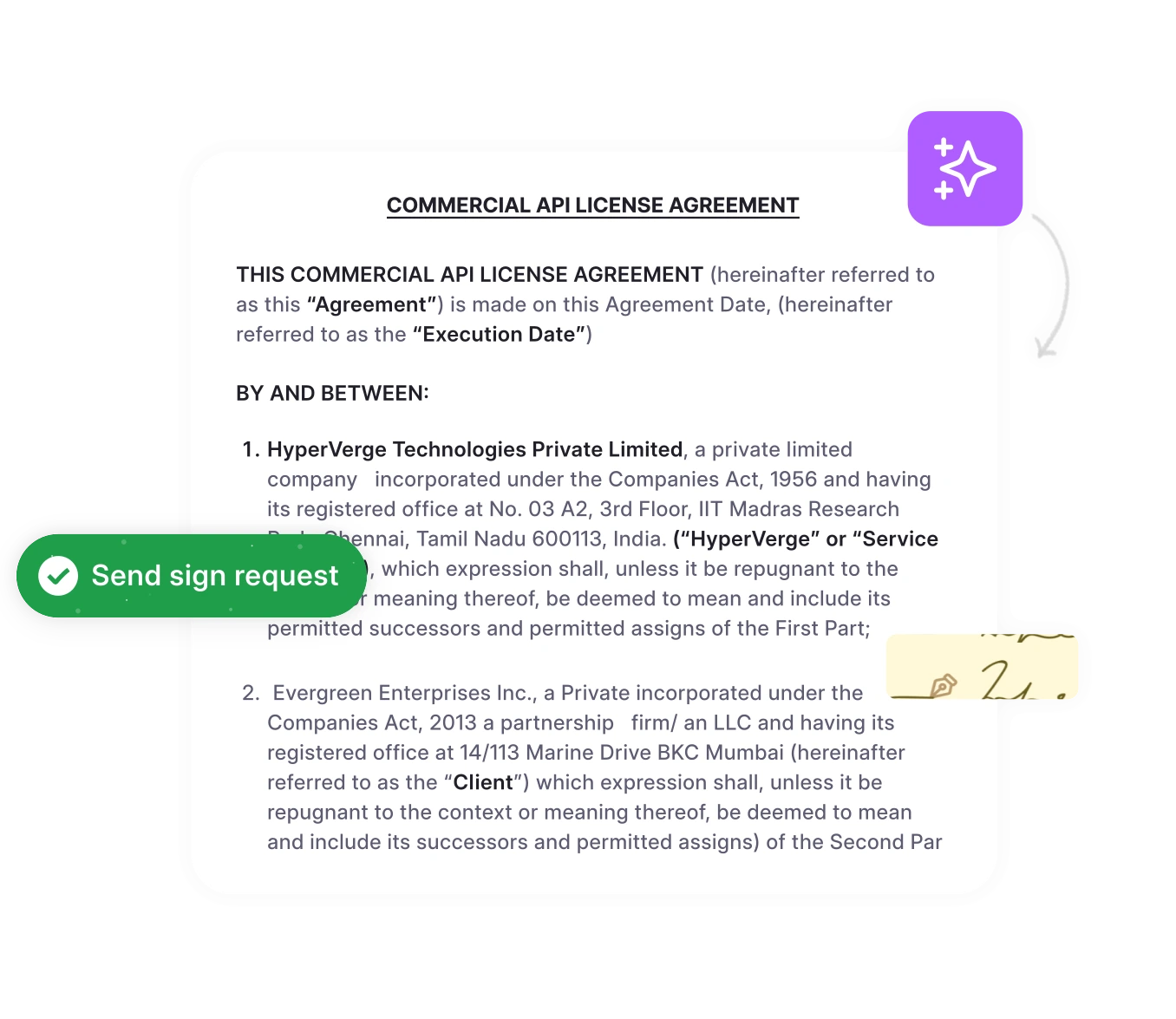A change order is proof that your business is evolving or has evolved since you signed the initial Statement of Work. Every order is an opportunity to reduce costs, deliver faster, and even generate new revenue.
For legal and procurement teams, mastering the change order process isn’t just about documentation—it’s about protecting your organization from risk while enabling business agility. In this guide, we’ll break down what change orders are, how to process them effectively, and how modern contract lifecycle management technology transforms contract modifications.
What is the meaning of a change order?
A change order is a written amendment to an existing contract that formally documents modifications to the original agreement. It captures changes to project scope, timeline, cost, or specifications after the initial contract has been signed.
Think of a change order as the official “update” to your contract terms. When the original contract value needs adjustment, when the project scope expands, or when unforeseen circumstances require modifications, a change order provides the documented framework to make those adjustments legitimate and enforceable.
In construction projects, procurement agreements, and government contracts, change orders function as critical contract amendments that protect both parties. They ensure any deviation from the original scope of work is formally acknowledged, priced appropriately, and approved by all relevant stakeholders before work proceeds.
Read also A Practical Guide to Construction Contract Management
Why a change directive exists
Change orders exist because no project operates in a vacuum. The business landscape shifts, client needs evolve, site conditions reveal surprises, and organizational priorities change. Rather than abandoning the entire contract, change orders provide a structured mechanism to adapt agreements legally.
As Girard R. Visconti, Esq., partner at Savage Law Partners, LLP, explains that change orders should be backed up with actual cost documentation, including labor, materials, equipment, vendor invoices, labor hours with rates, and material invoices. Proper backup documentation helps prove the value and necessity of a change order in court or arbitration.
Key Takeaway: Change orders protect both parties from confusion and risk. They formalize project changes that would otherwise exist in gray areas, preventing disputes about what was agreed upon and ensuring fair compensation for additional work.
Visconti also emphasizes that change orders should state the basis for the change, noting it would be practical to show why the change is not in the drawings, specifications, or the scope of work. For legal teams, this means every change order should be defensible. For procurement teams, it means every modification should be traceable back to a legitimate business need with clear cost justification.
Simplify change order management
From approval requests, manage every change efficiently with automation and visibility.
Book a DemoThe process of project changes
Managing change orders effectively requires following a structured process from identification to execution.
Step 1 — Identify the need with a change order form
Common triggers include scope expansion, material substitution, design updates, unforeseen site conditions, regulatory changes, and timeline adjustments. When any of these triggers occur, the affected party initiates a change order form documenting the proposed modification. What needs to change, why it’s necessary, and what impact it will have on cost and schedule?
Step 2 — Initiate change order request
The change order request moves through formal channels. Initiation can come from the contractor (when encountering conditions requiring scope changes), the project owner (when modifying specifications), or a consultant (when design revisions become necessary). The request should clearly articulate the business case for the change.
Step 3 — Reviewing and negotiating terms
This is where legal and procurement expertise becomes critical. The review phase involves validating pricing, assessing timelines, analyzing contract impact, evaluating risk, and aligning budget. Negotiation often follows initial review, where parties discuss alternative approaches, adjust pricing, or modify the scope to achieve mutual agreement.
Step 4 — Documenting and signing the change order
Once terms are agreed upon, the change order must be formally documented and executed, including reference to the specific contract, a detailed description of the change, updated contract value, revised project schedule, all backup documentation, and signatures from all authorized parties.
Note: Work should not proceed until the change order is fully executed. Performing changes without written authorization creates considerable risk. A contractor who performs work before approval has the potential to charge extra for work you never explicitly approved.
Step 5 — Updating budgets, timelines, and records
After the change order is signed, all relevant systems must be updated: financial systems, project management tools, contract repositories, and compliance records. Well-documented change orders prevent disputes later. Record change orders as soon as they happen and invoice promptly to maintain cash flow.
Read also: The Ultimate Guide to Post-Award Contract Management
Common types of change orders
Research shows that change order costs can represent 10% to 15% of the contract value on major projects. Separate analysis of over 18,000 projects found that the average cost of change orders varies between 4% and just over 5% over the duration of a project.
Additive change order
Additive change orders increase scope, cost, or time. These are the most common and arise when additional work is requested, project requirements expand, timeline extensions are needed, or costs increase beyond estimates. Procurement teams must carefully analyze where additional funds will come from.
Deductive change order
Deductive change orders reduce project scope or budget when portions of planned work are no longer needed, clients scale back requirements, or budget constraints require cuts. While seemingly straightforward, contractors may argue that reducing scope doesn’t proportionally reduce costs due to mobilization expenses and overhead allocation.
Substitution or replacement
These involve replacing specified materials, methods, or deliverables with alternatives while keeping the overall scope constant. The key question: Is the substitution truly equivalent? Does it maintain quality, performance, and compliance standards?
Partial termination
A partial termination cancels specific portions of contracted work while leaving the rest intact. These are legally complex because they involve questions about termination costs, contractor compensation for preparatory work, and potential claims for lost profits.
Furthermore, “changes in specifications by the owner” and “Change of plans or scope by the owner” are the top causes of change orders with the highest cumulative impact on project duration, cost, and quality. And changes that occur later in a project are significantly more costly than those made early in the process.
Fewer approval delays. Better change order control
HyperStart helps you centralize change requests, automate approvals, and keep every stakeholder on track.
Book a DemoUse cases of change orders
Example 1: Material availability issues
Research indicates that 35% of construction projects experience at least one major change. A commercial construction project specifies imported tile that became unavailable due to manufacturing disruptions. The substitution change order documents the reason, replacement specifications, cost differential (8% more), and timeline impact (minimal). Total additional cost: $14,500, but the project stayed on schedule.
Example 2: Design revisions requested by clients
A corporate office renovation that needs server room expansion for growing data infrastructure. The additive change order expands the room by 200 square feet, adds electrical capacity and cooling, revises the adjacent office layout, and extends the timeline by two weeks. Final change order: $87,000 additional cost.
Example 3: Unforeseen site conditions in construction change orders
An excavation that reveals soil contamination requires remediation before construction can proceed. Studies show that changes occurring later in a project are significantly more costly than those made early in the process. The emergency additive change order includes environmental testing, remediation expenses, engineering review, and delay costs. Total impact: $126,000 and four weeks.
Change orders vs. contract revisions in the original contract
| Type | Definition | Timing | Use Case |
| Change Order | Formal changes to project scope, cost, or timeline | After the contract signing, during execution | Client requests features, material substitution, and unforeseen conditions |
| Addendum | Changes to contract documents before signing | Before contract execution | Correcting bid errors, adding clarifications, and updating specifications |
| Revision | Administrative adjustment not affecting scope or cost | After approval for minor updates | Correcting contact info; updating payment details |
Change orders specifically alter project scope, cost, or schedule—material modifications to what’s being delivered and paid. Understanding these distinctions matters for approval authority and proper documentation.
Read also Managing the Service Agreement: A Practical Guide
The impact of change orders on projects
Cost implications and budget adjustments
Every additive change order increases overall cost, affecting budget forecasts, cash flow, profitability, and indirect processing costs. According to research, changes in specifications by the owner and changes to plans or scope by the owner are the top causes of change orders with the highest cumulative impact on project duration, cost, and quality.
Timeline and scheduling changes
Changes cause sequencing disruption, resource reallocation, downstream delays, and acceleration pressure. For procurement teams managing multiple projects, these impacts create conflicts across the portfolio.
Stakeholder communication challenges
Change orders introduce complexity in keeping everyone informed, managing expectations, maintaining cross-functional alignment, and ensuring documentation clarity. Modern CLM platforms address this with centralized visibility.
Risk and compliance considerations
Every change order modifies the project’s risk profile regarding performance, legal enforceability, regulatory compliance, and reputation. In government contracting, change order compliance is particularly scrutinized.
Read also 10 Steps to Effective Contract Change Management
How to manage change orders effectively
Standardize documentation and workflows
Create standard templates for change order request forms, approval matrices, review checklists, and documentation requirements. Standardization eliminates ambiguity and makes processing efficient.
Improve team communication and visibility
Break down silos with centralized repositories, notification workflows, status dashboards, and discussion threads. When everyone has visibility, duplicate efforts decrease and processing time improves.
Automate approvals and tracking
Automation delivers substantial benefits through routing automation, deadline tracking, approval workflows, and audit trails. For teams managing high volumes, automation is transformative.
Integrate contract lifecycle management (CLM) tools
Modern CLM platforms provide contract repository integration, version control, analytics and reporting, and budget tracking. An AI-powered CLM platform like HyperStart automates the entire contract lifecycle, including change order management, with full visibility from request through execution.
Establish clear change order policies
Put formal policies in place addressing when change orders are required, approval authority, timing requirements, documentation standards, and prohibition on unauthorized work.
Read also MSA vs SOW Explained for Legal Teams
Common mistakes to avoid
Failing to get written approvals
Red flag: A contract should require written approval for all change orders to avoid misunderstandings and unexpected costs. A contractor who performs changes without written authorization has the potential to charge extra for work you never approved.
Proceeding before pricing confirmation
Without agreed pricing upfront, owners face uncertain costs and contractors risk doing work without knowing payment. All pricing should be negotiated and documented before work begins.
Poor recordkeeping and audit trails
Scattered change orders across email, paper files, and shared drives create difficulty retrieving documentation, incomplete audit trails, lost change orders, and version confusion. Maintain a centralized repository.
Overlooking downstream impacts on project scope
Legal and procurement teams should periodically review all change orders holistically to ensure the cumulative effect is clearly understood and the overall project remains coherent.
Read also Agile Contract Management: Speed Meets Compliance
How technology simplifies change order management
Traditional change order management involves paperwork, email chains, manual routing, spreadsheet tracking, and constant status inquiries. Contract Lifecycle Management platforms automate workflows, provide real-time notifications, centralize dashboards, enable digital signatures, capture audit trails automatically, synchronize data, and identify patterns.
Organizations are seeing a 60-70% reduction in approval cycle time, near elimination of lost change orders, significant decrease in payment disputes, improved budget accuracy, and better compliance outcomes.
HyperStart’s approach: As an AI-powered CLM platform that automates the contract lifecycle, HyperStart maintains complete contract history, validates that change orders align with parent contract terms, flags potential issues, and ensures proper approval workflows. For legal teams, HyperStart provides confidence in proper review and documentation. For procurement teams, it delivers visibility and analytics for budget management.
Transform your change order process with HyperStart
Managing change orders doesn’t have to be chaotic. With the right approach and technology, change order management becomes strategic, protecting your organization while enabling business agility.
HyperStart’s AI-powered CLM platform transforms how organizations handle change orders by centralizing requests, automating approval workflows, providing real-time visibility, maintaining complete audit trails, integrating seamlessly with contracts and budgets, and delivering analytics for improvement.









